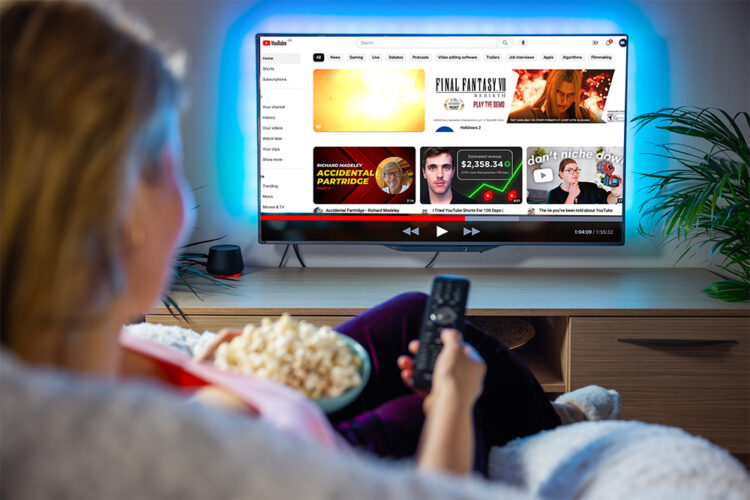Forget short-form, YouTube is going after TV

Opinion
The video platform is targeting the big screen, as watch time has become the number one predictor of channel revenue.
A little while ago, one of those perceptive reports from Enders arrived on my desk. It was an analysis of YouTube and picked up on a new detail in Alphabet’s quarterly earnings report. For the first time, Alphabet had broken out revenue from subscribers (to its YouTube Premium offering).
Based on latest data, 35% of YouTube revenue came from subscribers in 2023.
If YouTube Premium subscribers start to really grow, what does that do to monetisation and the great monolithic commercial structure of the web: ad-funded services? Does a Premium subscriber make Google more money than a “free” user?
Like Alice in Wonderland, I very quickly got lost down the rabbit hole of data. As one of the world’s largest distributors of premium video on YouTube, Little Dot has access to viewing stats on over 500 channels and 100bn YouTube views. There is a lot to discover.
What’s in a view
First question: if content is viewed by more Premium subscribers (ie. who see no ads), does that generate more or less money from a view?
Surely the headroom for monetising via advertising is restricted only by the appetite for advertisers to spend and then the auction mechanic ratchets up the price as demand increases? A subscriber just pays a flat fee to YouTube and can watch as much or as little as they want, all ad-free.
At Little Dot, we deliver content well over one hour in length and have begun to stitch together thematically linked shows into three- or four-hour marathons. These seem to be perfect for a TV audience, as we’ll later see.
When looking at revenue from Premium subs, the RPM (revenue per thousand views) was well above the channel average — by which I mean more than double.
Clearly, at this point, Premium really does mean premium.
Just like TV
But what makes a channel popular with a Premium subscriber? What we’re looking for here is content that works in a TV-like viewing experience — so a good place to start is stuff that was made for TV in the first place.
Next item on the checklist is content length. Those five-minute clips aren’t going to cut it; you need to be up and well over 30 minutes to really start to see views and watch time pick up.
Premium subscribers are watching “traditional” TV content, with watch times to match.
At this point, there are wider platform trends emerging.
Short-form competition
Readers will probably have noticed: for the last two to three years, the video industry has been dominated by the arrival of one platform: TikTok.
It has grown as big as YouTube (by views, anyway) and forced competitors to respond with me-too products like Reels and Shorts. There’s been navel-gazing about the future of humanity as we all succumb to the addiction of 30-second bites of entertainment.
However, YouTube can’t monetise Shorts to the same extent as regular videos; the opportunities just aren’t there, hence the big rights holders and publishers have been slower to jump in.
So YouTube is also working on the opposite end of its platform reach: the home.
Penning deals to rights for the NFL isn’t about competing with TikTok; it’s about growing the most compelling real estate of all — the big screen. This is where the big advertiser budget is and this is what we are seeing with our data.
Watch time is the watchword
In (overly) simple terms, TV viewers want to sit back and watch, not endlessly search, click, browse etc. Give me two hours of Gordon Ramsay on Kitchen Nightmares and I’ll decide when to switch off.
And we are seeing it. YouTube is undoubtedly targeting watch time as its KPI. Watch time has become the number one predictor of channel revenue — something that wasn’t the case as recently as two years ago.
Not only that, but the longer the content we distribute on our channels, the greater the number of views. A 10-minute clip might get 250K views on average (41K hours of watch time), whereas a two-hour video will see 500K views (1m hours).
That’s double the viewing and 25x the watch time. When watch time equals revenue, that is a phenomenal difference.
We see it with suggested videos too. Back in 2020, the average length of suggested videos across our biggest channels was 15 minutes. Today, that is 90 minutes. YouTube is telling us exactly what it wants: long content.
So how do we respond? We think like a TV channel. Channel branding, signposting users to long content, thumbnails that work on the big screen.
Pretty soon, YouTube will overtake Netflix for TV viewing. Think you know YouTube? Think again.
 Graham Swallow is head of data and product strategy at Little Dot Studios
Graham Swallow is head of data and product strategy at Little Dot Studios




